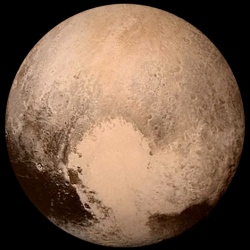
From commercial space to space lettuce, 2015 was a bumper year for exploring the Solar System and beyond. To get the low down on the high ground, Gizmag looks back on the highlights of space exploration and technology over the past twelve months.
New Horizons
2015 was the year when mankind visited the last and outermost of the classic nine planets. On July 14, NASA’s New Horizons spacecraft executed a flawless flyby of Pluto and its moons. The nuclear-powered unmanned probe sped past the dwarf planet at a distance of 12,500 km (7,750 mi) and a speed of 14 km/sec (31,000 mph), making it the final classical planet to be visited by a spacecraft.
Dawn at Ceres
NASA’s Dawn spacecraft added another trophy to the conquest of space on March 6 as it went into orbit around Ceres, making it not only the first spacecraft to reach a dwarf planet, but also the first to orbit two extraterrestrial bodies. Altering its orbit using its ion thruster, it’s still returning new data on the elusive inhabitant of the Asteroid Belt.
Rosetta
Meanwhile, ESA’s Rosetta probe continued to follow Comet 67P/Churyumov-Gerasimenko as it reached perihelion, or the point where its orbit came closest to the Sun. On August 13, the comet and unmanned probe came within 186 million km (115 million mi) of the Sun and turned back toward the outer Solar System.
The first spacecraft to orbit a comet, Rosetta will continue to study 67P until it travels too far from the Sun for its solar panels to work, after which it will make a controlled landing on the comet. Unfortunately, though Rosetta was able to reestablish contact with the Philae lander, it soon fell silent again.
Cassini Enceladus flyby
In October, NASA’s veteran Cassini probe made the first of its final series of flybys of the Saturnian moon Enceladus. The orbiter’s mission to Saturn has lasted over 18 years so far, a considerable extension of its original four-year timetable.
As its mission draws to an end, the unmanned, nuclear-powered spacecraft executed its final three flybys of Enceladus through December to provide a better understanding of the moon’s global ocean and its possible habitability.
Akatsuki
2015 was also a rare year of second chances as Japan’s Akatsuki Venus orbiter came back from an apparent failure. On December 6, JAXA confirmed that its probe successfully made it into orbit around the planet Venus on its second attempt. The first try was way back on December 7, 2010, when a malfunction of the main engine sent the spacecraft back into orbit around the Sun.
On arriving back at Venus, the unmanned spacecraft successfully fired its auxiliary reaction control system (RCS) thrusters under automatic control for a 20 minute burn that sent into a high orbit around the planet.
Plutonium back on the menu
One particularly optimistic note on the space front is that the US restarted production of plutonium 238 (PU-238) after a pause of almost 30 years. The civilian stockpile of the plutonium isotope used to power the radiothermal generators (RTG) that make electricity for US deep space probes has dwindled to only 35 kg (77 lb), so when the US Department of Energy’s Oak Ridge National Laboratory (ORNL) made the first 50 g (1.7 oz) of plutonium oxide at its Tennessee facility, it was a major turnaround in American space capabilities.
Commercial space comes of age
Also back on Earth, commercial spaceflight not only made a comeback from a series of launch failures, but also set its own firsts. In December, the unmanned Orbital Sciences/ATK Cygnus CRS-4 mission lifted off from Space Launch Complex 41 at Cape Canaveral Air Force Station in Florida as the company returned to space after the explosion of its Antares launcher at NASA’s Wallops Island Facility in 2014.
Meanwhile, Steve Bezos’ Blue Origin entered the ranks of commercial spaceflight as it executed its first powered landing in November in a proof of concept flight 1,524 m (5,000 ft) over west Texas.
However, it was SpaceX’s Falcon 9 that took the prize as its Falcon 9 not only returned to flight after a midair explosion in June, but also flew into the history books as it became the first space rocket to make a controlled powered landing after delivering 11 communication satellites into low-Earth orbit.
Space food and drink
If mankind is going to move out into space, it can’t just be a matter of probes and rockets. The inner astronaut needs to be fed as well, so experiments aboard the International Space Station (ISS) this year concentrated on food and drink for future space travelers.
In August, the ISS was the scene of an historic lunch with the crew members of Expedition 44 dining on the first meal harvested in space. The dish, which consisted of leaves of "Outredgeous" red romaine lettuce grown in NASA’s "Veggie" zero-gravity greenhouse, is part of the space agency’s effort to find ways to feed tomorrow’s deep-space travelers.
In May, mornings on the International Space Station (ISS) got a bit brighter as the first cup of espresso coffee in space was brewed and drank on the station by Italian astronaut Samantha Cristoforetti. To celebrate, Cristoforetti tweeted back to Earth a photo of her imbibing the brew, saying, "’Coffee: the finest organic suspension ever devised.’ Fresh espresso in the new Zero-G cup! To boldly brew…"
But in Scotland, in a move that Star Trek’s Mister Scott would approve of, Scottish distiller Ballantine’s developed a glass for sipping whisky in zero gravity. The Space Glass applies some clever physics to recreate the experience of drinking spirits from a glass on Earth and might well be a more attractive proposition for astronauts and future space tourists than using plastic bags and straws.
